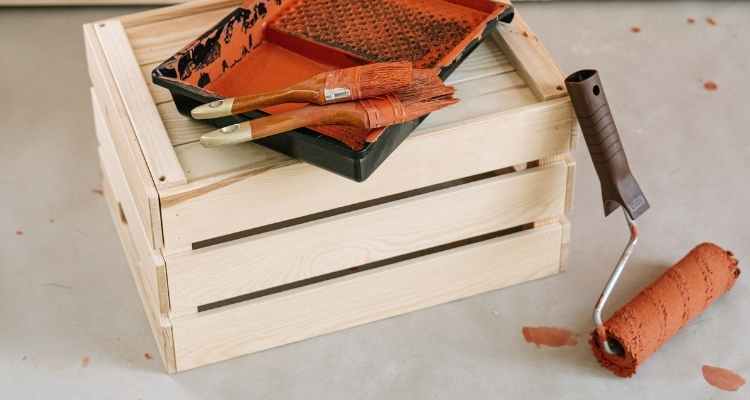Table of Contents
How to Paint a Ceiling - When you are painting a ceiling, it is important to take into consideration the type of paint that you will be using. For example, if you are painting with latex paint, then it may be best for you to use a roller rather than a brush. How long should I leave the paint on before I start rolling or brushing? How do I know when my rollers and brushes need more paint? These are just some of the questions answered in this article!
You may want to leave the paint on your roller or brush for a few minutes before rolling, so that it can start absorbing into the bristles. How long you should wait will depend on how thick your paint is and what type of surface you are painting (e.g., drywall versus wood). How do I know when my rollers and brushes need more paint? How do I keep the roller or brush from sticking to the ceiling while painting it? These are just some of the questions answered in this article!

The best way to paint a ceiling with a roller is by rolling horizontally, from the bottom up. This technique will ensure that there are no runs in your finished painting job and it also helps avoid having too much paint on your brush since it's rolled off as you go. How do you know when my rollers or brushes need more? How do I keep them from sticking to the ceiling while painting it? These are just some of the questions answered in this article!
What should we wear while working on our ceilings? What if we make a mistake during the finishing process (e.g., leaving fingerprints)? How can I handle an airless sprayer for interior walls? How long does drywall mud take to cure before I'm able to paint or paper it?
How do I remove the old ceiling tiles away from my studs? How can I clean up and dispose of materials when done painting a ceiling? How should I prepare for priming the drywall before painting or papering it so that there is no unwanted texture in my finished product? These are just some of the questions answered in this article!
There are many types of rollers, I like to use a medium nap roller. The short bristles will help you push the paint into all those seams and crevices in your ceiling so that it dries evenly without any brush strokes or blemishes on the surface.
Another option is atypical roller with long flexible bristles which you would want if your ceiling has textured panels or uneven surfaces because they'll provide more coverage than a standard round-bristled roller while still doing an excellent job of spreading the paint over those imperfections. If there's not much texture on your walls, then go for this type!
No, you do not need to prime a ceiling before painting.However, there are some things that should be considered when choosing the best type of paint for your space because it's important to know how well each will adhere and hold up over time in different conditions. For example: If you have low ceilings with an open floor plan then look for high-hiding paints like flat or eggshell (or even better yet satin) so that any dirt won't show through as much on this highly reflective surface. On the other hand if most surfaces around your home are textured then opt for semigloss - although these can still be prone to showing dirt from less than thorough cleanups! How long does it take? It depends on the size of your ceiling, how well you plan to cover it and your level of expertise.

It's important to know what type of surface the paint will be applied on. Ceilings can be a reflective or non-reflective surface, and each has different needs when it comes to painting finishes. One thing that should never happen is applying glossy paints over drywall as this creates an uneven seal which leads to flaking in the future. How long does it take? It depends for how big your ceiling is, how well you plan to cover it and your level of expertise."
The best finish would depend upon whether your ceilings are reflective or not: if they're not then any kind of high gloss/semi-gloss; but if they are then flat/eggshell (or even better yet satin) because of the reflective qualities. How long does it take? It depends for how big your ceiling is, how well you plan to cover it and your level of expertise."
"As a general rule of thumb, speeds can be anywhere from ten minutes per square meter (or sq. ft) or two hours per gallon - whichever takes longer! If you're covering an even amount with one coat then that's going to depend on the thickness; otherwise just work out what would use up more paint based on surface area rather than volume and adjust accordingly. How many coats do I need? That again depends upon whether you have light-colored walls or not as this will reflect the color onto your ceilings if they're in close proximity to each other which may make it more difficult to cover. How many coats do I need? That again depends upon whether you have light-colored walls or not as this will reflect the color onto your ceilings if they're in close proximity to each other which may make it more difficult to cover."
It's a good idea to open windows and doors, turn on fans (bringing them outside), and use exhaust systems when painting indoors - so remember these steps before you start. You can also wear an N95 mask or simply leave the house while spraying paints like lacquer, varnish, aerosol cans and degreasers are being used."
The easiest way to paint a ceiling is by dividing it into smaller sections. To do this, you'll need two ladders or scaffolding towers that are taller than the height of your ceiling and tracing paper. Hold your tracing paper along the top edge of one ladder or tower the side closest to where you're standing and then lay down another piece on top, but perpendicular to the first so it's running long ways rather than short. Now step back until both pieces trace their respective lines across from each other, creating a box-like shape in which all four sides will be equal."